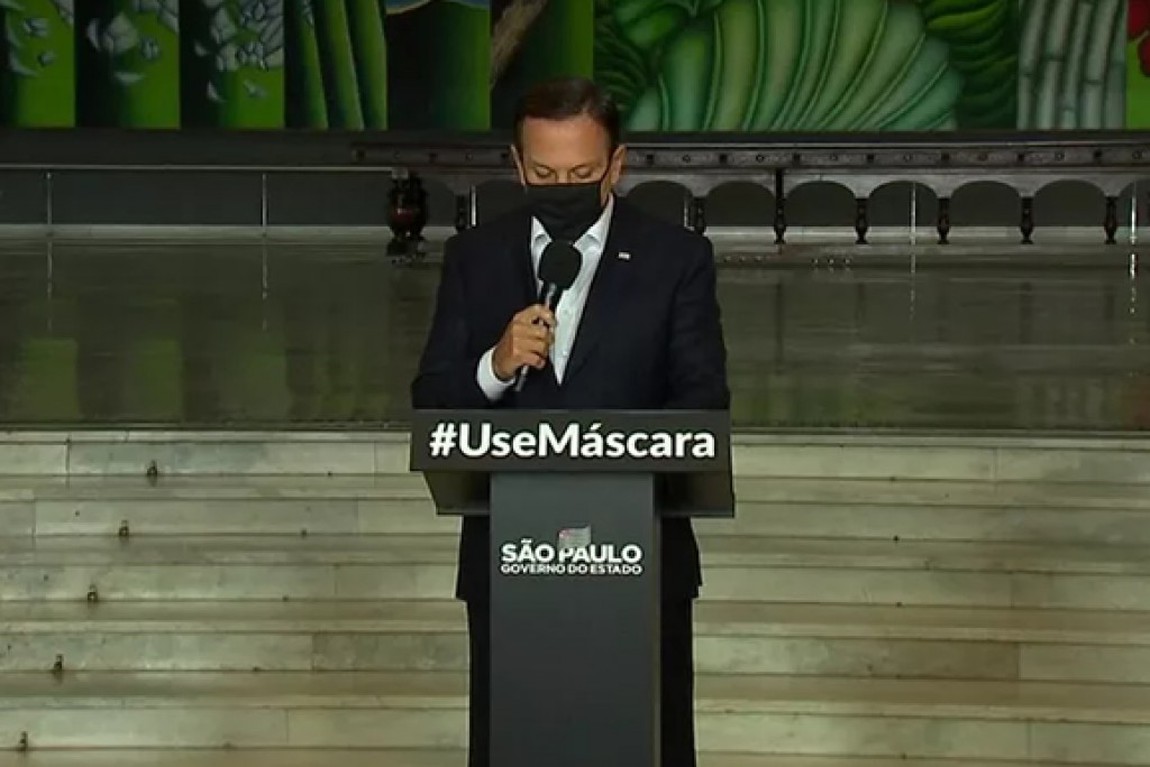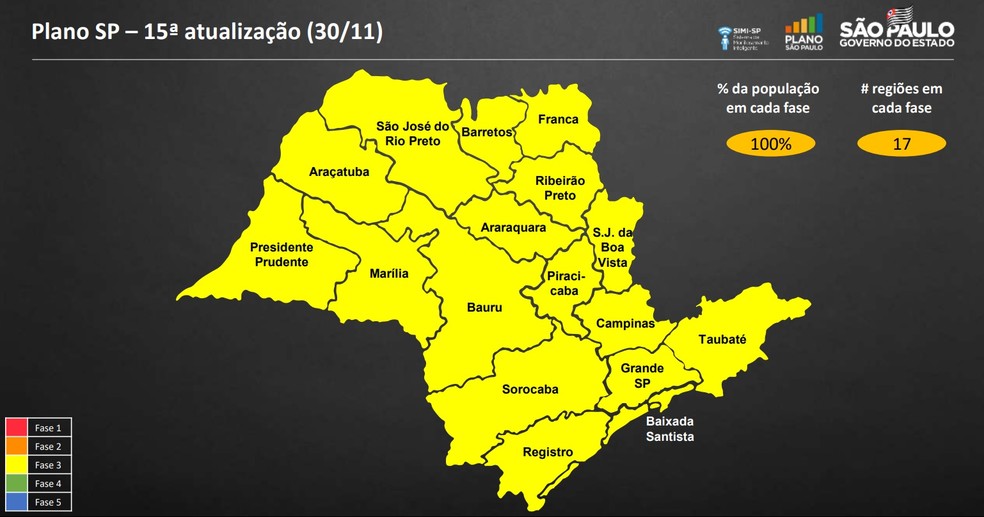RIO DE JANEIRO, BRAZIL – The city of São Paulo will regress to the yellow phase of the São Paulo Plan, as well as the other regions of the state that were already in the green phase. With the decision by the state Governor, João Doria, businesses and services will once again operate fewer hours a day.
The regression phase was announced one day after the second round of elections in São Paulo, won by Bruno Covas – the re-elected Mayor supported by state governor João Doria.
The change does not alter the back-to-school schedule, allowing schools to remain open.

Under the yellow phase, the occupation of establishments is limited to 40%; business is limited to staying open only 10 hours a day, with mandatory closing at 10 PM; and events with a public entry (e.g. soccer matches, musical events) are banned.
Cinemas and theaters will not have changes to their operation. In the case of parks, the opening hours are subject to municipal assessment. The measure will be effective from Wednesday, December 2nd after the decree is published in the State Gazette.
The capital was in the green phase, the mildest in terms of restrictions, as were the regions of Campinas, Sorocaba, and Baixada Santista, totaling 76% of the state’s population. The rest of São Paulo continues in the yellow phase.
With the drop in the number of cases in September, the updates of the São Paulo Plan, which were conducted every two weeks, became monthly. However, the November 16th update was deferred until after the second round.
At the time, the state government interrupted a number of phase progressions it had been promoting and, while not accepting the worsening situation, claimed that the interruption was due to instability in the Ministry of Health’s system -which had occurred the preceding week-, as it could misrepresent the data and some cities could mistakenly migrate to the green phase.
In a press conference on Monday afternoon, November 30th, Governor João Doria, as well as the other members of the Coronavirus Contingency Center, stressed that the decision to defer the plan’s reclassification was made based on the observation of indicators and denied that there was any political factor involved in the decision.
State Health Secretary Jean Gorinchteyn also stressed that the decision to migrate all 17 regions of the state to the yellow phase came after the review of Friday and Saturday’s data, November 27th and 28th. According to the São Paulo State Health Secretariat, hospitalizations on Saturday were almost 20% higher than 28 days ago.
The state recorded a 12% increase in the number of deaths and 7% in the rate of hospitalizations last week. The number of cases dropped by 14%, according to Gorinchteyn. The ICU bed occupancy rate in São Paulo stands at 52.2%. In Greater São Paulo, this rate rises to 59,1%.
The new classification will be in force until January 4th, 2021, but it could be changed if an alteration in indicators is perceived, which will be reassessed every seven days.
Experts had been alerting to the worrisome increase in Covid-19 indicators in São Paulo in recent weeks. However, the state and municipal governments were reluctant to immediately re-examine the situation in São Paulo, despite private hospitals’ growing occupancy of beds intended for patients with the novel coronavirus.
Albert Einstein and Sírio-Libanês private hospitals were among those with a recent increase in Covid cases, triggering an alert among doctors at a time when preventive measures against the disease, such as social distancing, avoiding crowds, and wearing masks, have been continuously disregarded.
Many of the municipal hospitals have already reserved wards for expanding beds to treat Covid-19 patients. According to the city hall, the network would receive 200 new beds in wards and ICUs this week.
On Monday afternoon, Mayor Bruno Covas said that the city should not reverse any opening.
“There is no room for alarming rhetoric once again about a ‘lockdown’. That was not what was said today. We will not close anything. But there’s also no room for ‘it’s over and life is back to normal’ talk. The pandemic is still a challenge to be addressed. We will follow the municipal health surveillance guidelines. That’s the direction I’ve been following and I’ll continue to follow until we have a vaccine.”
The City Hall announced in a note that it will wait for the publication of the state government decree to disclose the “adjustments that all of the city’s economic sectors will need to follow with the change in the process of gradual and conscious resumption in the municipality.”
The Covas administration also reported that the pandemic remains stable in the city and that the ICU and ward beds occupancy rate on Monday stood at 52%.
On Tuesday, December 1st, the state government will hold an online meeting with the 62 municipalities where Covid-19 hospitalizations and cases are of greatest concern. The capital is not among them.
According to the State Secretary of Regional Development Marco Vinholi, these are cities with over 70,000 inhabitants which have presented a 10% or higher increase in hospitalizations of patients with coronavirus or which record over 75% occupancy of beds for the treatment of the disease.
On December 7th, another meeting will be held with the newly elected mayors to explain how the São Paulo Plan operates and what measures are being taken. The municipalities will also be directed to increase testing in order to better track the incidence of the disease and promote the isolation and treatment of people infected.
Over the coming days, the government should also announce an increase in inspection in the state. According to Gorinchteyn, between July 15th and November 15th, 110,000 inspections were conducted and 1,000 establishments or people found in breach of the rules were fined. The efforts will be intensified and the number of inspectors should quadruple, with the adherence of municipalities, according to the Secretary.
The governor also said he intends to implement measures to ban public or private parties in order to prevent crowds. Without providing details, Doria said that the legal measures to be announced should override municipal ordinances.
“It’s not the time to party. It’s not the time to celebrate. . We may only have parties and celebrations again after the vaccine,” he said.

Entities challenge decision
Trade associations challenge the effectiveness of regressing to the São Paulo Plan’s Yellow Phase to fight the increase in Covid-19 cases. According to them, aside from the fact that the measure has a political nature since it was taken after the second round of elections, there is no evidence that new transmissions of the disease have occurred in commercial establishments.
“To avoid crowding, the government should allow trade to operate longer hours and have more room to accommodate customers. It makes no sense to regress to a plan that was drawn up months ago when the situation was different,” says Marcel Solimeo, economist of the São Paulo Trade Association.
He explains that traders were taken by surprise with the decision, because they had full stocks, hoping to offset part of this year’s losses. “Trade incurred large costs to adjust to protocols and needs the December profits to pay the accumulated taxes, in addition to loans and expenses with burdens. This restriction now makes no sense”.
The concern is also shared by Percival Maricato, chairman of the state council of ABRASEL-SP (Brazilian Association of Bars and Restaurants of São Paulo). “It is disappointing and very unfair to our sector. We were expecting to have sidewalks cleared for table placement, in addition to the maintenance of what we had already achieved, to pay the bills.”
The profit with the year-end sales would serve to pay the employees’ 13th salary, in addition to taxes and rents that accumulated during the year, according to Maricato. “With a reduction to 40% of bars and restaurants’ capacity, to stay open leads to more loss than profit.”
In his opinion, the bar and restaurant sector is complying with all determinations imposed and, nevertheless, it will be once again punished with restrictive measures. “We are not to blame. There are crowds unrelated to restaurants. Now, with fewer tables and limited opening times, more people will gather at the door than before. This restriction is counterproductive.”
According to Nabil Sahyoun, chairman of ALSHOP (Brazilian Association of Shopping Malls Storeowners), shopping malls’ losses will be much higher, because this time of the year they customarily extend their working hours. “We don’t lose two hours opening. We lose from three to four. The right thing would be to operate 14 hours per day, for consumers to be able to do their shopping at alternative times,” he says.
Sahyon also points out that the change was announced right after the second round of elections. “We had hundreds of city councilors and mayoral candidates campaigning and forming crowds and we noticed that no one cared about that. Now the election is over and restrictions are coming back. Society will pay for an incoherent decision, guided by political decisions. Why not fight where the actual crowds are found in the cities?” he asks.
For Maricato, public authorities should also inspect and seek options for the places where people crowd, rather than restrict trade. “We have subways, buses, free markets, illegal trade. We had the elections. Closing restaurants does not solve these crowds. But it seems that this government does not want to mobilize society. We can’t just stick to the governor’s words. What do the rest of society think? We’re going to mobilize organized civil society to engage in dialogue with the government,” he says.
Source: Folha de S.Paulo

